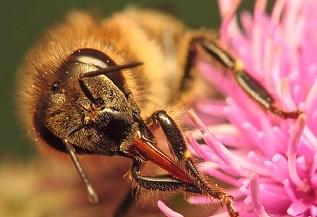Introduction

Eventhough the honeybee is a model species in insect olfaction, knowledge about the spectrum of odorants that honeybees are able to perceive is somehow limited. One class of odorants that has never been tested with honeybees so far are the amino acids. This is surprising given that free amino acids are the second most abundant group of compounds in nectar (Baker and Baker 1973, 1986), and given that the behavior of honeybees suggests that they prefer nectar containing amino acids over solutions containing only sucrose (e.g Alm et al. 1990; Carter et al. 2006 ; Inouye and Waller 1984; Petanidou et al. 2006).
When determining the responses of honeybees to amino acids dissolved in an aqueous solution mimicking floral nectar, Inouye and Waller (1984) found that honeybees preferred weak solutions of some amino acids over a sucrose control. Alm et al. (1990) also demonstrated that honeybees preferred solutions containing a mixture of amino acids over solutions without amino acids. Carter et al (2006) found that honeybees both preferred and consumed artificial nectar containing moderate (2 to 6 mM ) levels of proline. More recently, Bertazzini (2010) showed, with the use of a dual choice feeding test, that artificial nectar containing proline and alanine was preferred over sucrose alone. It is thus reasonable to assume that the senses of smell and/or taste play an important role in the foraging decisions of honeybees (Carter et al. 2006).
Honeybees collect nutritious nectar and pollen wherever it is accessible, and store it to secure a food supply for periods of starvation. Consequently, in order to accomplish successful foraging, honeybees’ associative learning abilities are very important for their survival (Menzel 1993). Environmental cues, such as landmarks and special features of a food source (odor, color etc) are learned and associated to a reward, i.e. food (Masson et al 1993). Bees usually visit many different places and, as a result, learn several different flower cues throughout its lifespan (Masson et al 1993). It is thus crucial for the bees to quickly learn to associate visual and olfactory cues with a food reward (Menzel 1993). Since amino acids are the second most abundant group of compound in nectar, it is possible that they are detectable to pollinating insects and thereby might have an impact on their foraging decisions.
The aim of the present study was therefore to evaluate whether honeybees are able to perceive the odor of amino acids, and at what concentrations the amino acids are detectable. To this end, the proboscis extension reflex (PER), a classical conditioning paradigm that takes advantage of the honeybee’s ability to build a robust association between an odor stimulus and a nectar reward (Bitterman et al. 1983) was used.
Responsible for this page:
Director of undergraduate studies Biology
Last updated:
05/17/11
